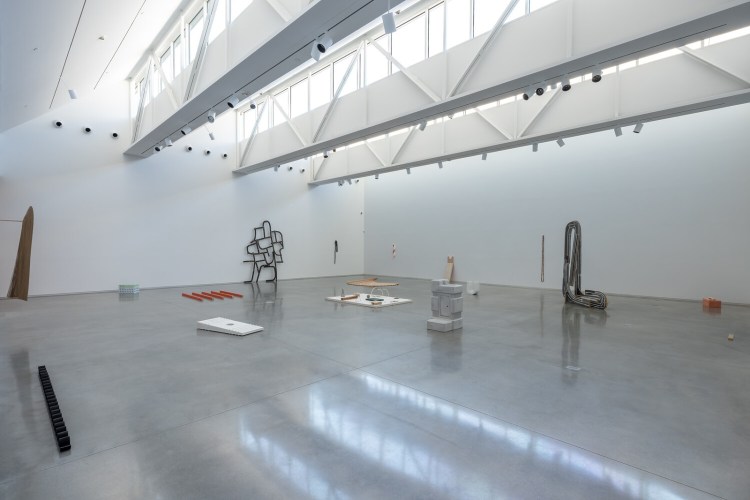ROCKLAND — From the moment he walked into the large open main gallery at the Center for Maine Contemporary Art, Timothy Peterson imagined, and wondered, how he would use the space to display sculpture.
The center’s new executive director and chief curator, Peterson begins answering that question, for himself and others, with the first show he has curated since he joined CMCA earlier this year. “Spatial Relations” is a three-person exhibition of sculpture by Elizabeth Atterbury, Gordon Hall and Anna Hepler, who are showing work made with a variety of materials, including wood, concrete, metal, ceramic, cardboard – and even peach pits – designed to rest on the floor or hang on a wall, without pedestals or other support systems.
Peterson and curatorial assistant Rachel Romanski chose the work and installed the exhibition to create interplay among the artwork and within the space itself. “We have four skylights facing north, so as this show progresses from October into January, it should feel a lot like an indoor sculpture garden,” Peterson said.
Added Romanski, “After the last couple of years of stress, we wanted to create a space that felt peaceful, contemplative and beautiful.”
They would have placed a bench for people to sit among the sculpture, but nixed that idea because the bench might have been confused as art in this minimalist, post-modern installation.
The title of the exhibition, “Spatial Relations,” is a term from science, referring to how an object is located in space in relation to another object. In this exhibition, much of the work relates to other work in color, form and overall flow, and the curators have arranged it so visitors can experience it intuitively, based on how they feel within the space. There is no obvious path to follow, other than to be guided by one’s own instinct.
The artists are friends and acquaintances and familiar with each other’s work. All have Maine ties.
In “Spatial Relations,” all are taking inspiration from everyday objects and transforming them into art objects, remaking them with their own imaginations, unlikely materials and an intentional use of color that is integral to the material and the texture. “I see a lot of repetition and I see a lot of rhythm that exists within works, where there are elements that bounce off each other. Some are enhanced by being in context with other works,” Romanski said.
“There is a lot to be discovered,” Peterson added.

“Into Action” is a thematic exhibition of photography and photo-based art by Cig Harvey, Julie Poitras Santos, Shoshanna White, Jennifer Calivas, Mark Dorf and Ray Ewing. Photo by Dave Clough, courtesy of David Clough Photography and CMCA
“Spatial Relations” is among four new fall exhibitions at CMCA, all on view until Jan. 9. “Into Action” is an exhibition of photography and photo-based work by an A-list group of contemporary artists working in and associated with Maine: Cig Harvey, Julie Poitras Santos, Shoshanna White, Jennifer Calivas, Mark Dorf and Ray Ewing. “Absent,” by video artist Hiraki Sawa, makes use of CMCA’s new video equipment with a surreal 4-minute, 27-second video of dancing cups, walking tea kettles and flying spoons.

“Switch the Code” is a 33-foot wall painting by Portland artist Ryan Adams. Photo by Dave Clough, courtesy of David Clough Photography and CMCA
Finally, CMCA also is hosting the exhibition “Lessons” by Portland artist Ryan Adams, which consists mostly of small paintings on wood panels but dramatically features a 33-foot site-specific mural called “Switch the Code.” Painted on the courtyard-facing wall and visible to the outside world through CMCA’s glass exterior, the gem-style mural embeds the words “Use Your White Voice.” The title refers the social practice of code-switching, in which people adapt their speech, behavior and appearance to either fit in or to be seen outside of cultural stereotypes.
Adams completed the large painting on site, and made the smaller geometric paintings during residences at Hewnoaks and Indigo Arts Alliance. Peterson, who became familiar with Adams’ work during the recent Portland Museum of Art biennial, appreciates Adams’ ability to work dimensionally with paint and text together, and at a grand scale.
Featuring Adams’ work in the public-facing spaces is part of Peterson’s strategy to create more distinct exhibitions and draw people to the gallery with big, bold contemporary art.
“I saw the attention Ryan got at the PMA and wanted to meet him and see his work,” Peterson said. “He is the real deal. He is phenomenal. I asked what he would want to say if he had a 33-foot-long wall facing a public courtyard, and he got back to me a week later with this statement – ‘Use Your White Voice’ – which was a tactic he used as a Black youth growing up in Portland.”
As a gay man, Peterson said he was familiar with code-switching. For him, it might be, “Use Your Straight Voice.”
“Code-switching is something that people learn to turn on and off at a very young age,” Peterson said. “It’s a common tactic not to be seen as other, and to be seen as acceptable and employable, among other things.”
For a virtual tour, visit cmcanow.org/virtual-tours/. For details about visiting in person, cmcanow.org
Send questions/comments to the editors.




Comments are no longer available on this story